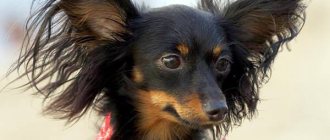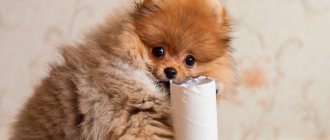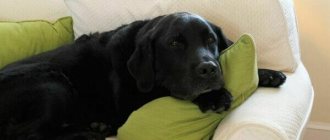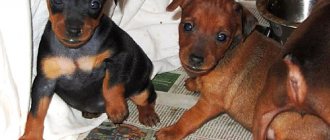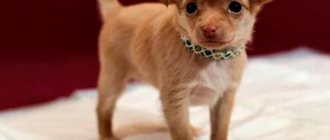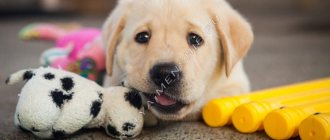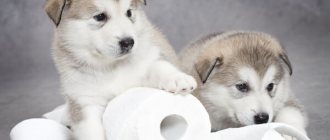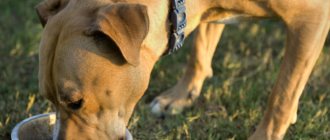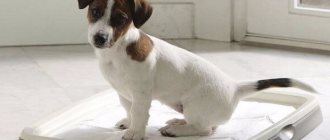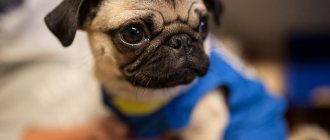Toy terriers are active, playful and affectionate dogs that make wonderful friends.
Proper care for them is the key to a long and healthy life.
They do not require complex coat care, but when keeping them in the house, it is necessary to take into account the breed characteristics.
You should also take into account the gender of the pet, since caring for males of this breed is slightly different from caring for females.
How to care for a puppy
Even before the puppy appears in the house, care must be taken to make the house or apartment safe for him.
It is necessary to remove all unstable objects that could fall on the baby, as well as anything that poses a danger to him: electrical wires, balls of thread, sewing supplies, medicines.
When you bring a pet into your home, you need to follow all the breeder’s recommendations: feed the baby correctly, give him vaccinations on time and carry out other medical measures, such as deworming or preventive treatment for external parasites.
In the first half month, the puppy should eat only the food that the breeder recommends, and only later will it be possible to gradually transfer the puppy to the diet that is more convenient for its new owner.
A Toy Terrier puppy must be handled with care and caution, as it is very small and fragile.
You cannot buy a Russian Toy Terrier as a gift for a child who is under 6-7 years old, as he may involuntarily injure the pet .
Grooming your Toy Terrier puppy includes cleaning the ears, eyes and teeth, and trimming the nails. All these procedures are performed as necessary. But it is not advisable to bathe a small toy, as puppies of this breed get cold easily.
Safe environment
Remember that the puppy does not have any experience yet, and he is capable of getting his tiny head into very big trouble on his own. Your apartment is quite safe for you, an adult and intelligent creature, but for a small toy terrier it can be full of traps, sometimes deadly!
Inspect the home before the new tenant arrives and think about where the danger may lie :
- Close all holes and cracks where your pet could get stuck and get stuck, or at least just poke their head through.
- Solve something with wires on the floor - the puppy may try them out.
- Check to see if you have any large but not very stable interior items that could crush the dog if they fall.
- A bed for a Toy Terrier puppy should have small sides or no edges at all, and do not take a puppy whining in the first nights into your bed! Firstly, he doesn’t belong there, he has his own place. Secondly, he may fall and get injured.
- Toys for toy terrier made of soft rubber; Before changing teeth, do not play tug with him - do not pull the toy. You can break them or ruin your future bite.
- Do not place your dog on high surfaces, such as a table, unless it is, of course, an examination by a veterinarian or a photo shoot. Firstly, it is traumatic. And secondly, do you need a well-mannered friend or a spoiled living toy who will climb into the plates of your guests? If the latter, then keep in mind: many people find this dog behavior not at all endearing!
Basic rules for caring for an adult dog
An adult dog also needs to be brushed, bathed if necessary, its eyes, ears, teeth cleaned, and its nails trimmed.
It is not recommended to wash it too often, and, if possible, it is better to do without bathing at all.
From the first day of its appearance, a toy terrier should have its own place in the house..
You should not allow him to sleep on a bed, sofa or chair, as the pet may be injured when jumping from there.
Careful monitoring and care of the condition of teeth is necessary, as they are predisposed to early loss.
Expert opinion
Kozhevin Semyon Kirillovich
Expert dog handler.
“Care for an adult toy terrier includes brushing, cleaning eyes, ears and teeth, and, of course, timely shortening of nails. A long-haired dog will also need grooming. The Toy Terrier's teeth require special care, as tartar easily forms on them. Due to the fact that these dogs get cold easily, it is necessary to ensure that the pet is not in a draft, and when it gets cold, dress it according to the weather.”
Important information before purchasing a puppy
Toy Terrier dogs are very friendly and easy-going, they easily stay near people and can get along with other animals. The weight of a toy terrier is no more than 2.5 kg, and a mini terrier - 1.5 kg.
Dogs are usually cheerful and love to frolic and run fast. Such animals need constant care and attention and must be under the supervision of a loving owner, since caring for them has a number of features.
Before buying such a puppy, you need to prepare the apartment or room where he will be located. Check all cords from electrical appliances that hang low so that your pet does not pull them with his teeth, hide all sharp and cutting objects, and also hide all cleaning supplies and medications. Prepare in advance a quiet and comfortable place without access to cold air.
Dogs of this breed cannot be kept in the bathroom or restroom, and it is also not recommended in the hallway: the place should be spacious and bright, without heaters .
Necessary purchases for a puppy
Before purchasing a dog, take care of the necessary supplies such as:
- folding house;
- cotton pillowcase;
- ceramic bowl and mat under it;
- metal comb and long-tooth comb with high handle;
- massage brush, blunt-tipped scissors;
- ear hair tweezers;
- specialized dog shampoo for long hair;
- ear liquid, hair dryer;
- rubber toys;
- small tray;
- latex toothbrush, bones to prevent plaque;
- meat-flavored toothpaste;
- dry food;
- cotton clothing for dogs for all seasons, a carrying bag, a bacterial collar, medications for worms and ticks: this is a minimum program for caring for a toy terrier dog.
What you need to prepare before buying a dog
Before you bring a toy terrier into your home, you need to prepare in advance what you will need to care for a pet of this breed.:
- Bed or hard mattress.
- Tray or diaper.
- Toys. Those sold in veterinary pharmacies and pet stores are suitable: made of veins, silicone, rubber, in the form of braided ropes, balls, etc.
- Small metal or enamel bowls for food and feed.
- Grooming brush.
- Toothbrush and toothpaste designed for puppies.
- Zooshampoo.
- Food recommended by the breeder or the necessary set of products if the baby eats natural food.
- Vitamins for puppies.
You should not feed or water toy terriers from plastic bowls, as they often cause allergies in animals.
Toy Terrier nutrition
What to feed the animal—natural food or dry food—depends on the owner. If the owner decides in favor of regular foods, it is important that the toy’s diet is balanced. Small terriers can be given:
- lean meat;
- sour milk;
- offal (except lungs, kidneys and udder);
- vegetables.
Everything should be either boiled or scalded with boiling water.
If the owner has a preference for dry food, it is worth choosing products labeled “for small breeds.” It is also necessary to take into account the age and health of the terrier.
Important! Regardless of what exactly the cat eats, natural or food, he should always have access to clean drinking water.
First days at home - what to do
The first time after purchasing a pet, the house should be quiet and calm.
No visits from friends and relatives are allowed at this time: not only will the guests irritate the baby, but they can also carry pathogens of dangerous infections on their clothes or shoes.
From the very first day, you need to start accustoming your pet to its place and tray: this will help avoid problems in the future..
If the toy terrier has already been vaccinated and has passed quarantine, then you can gradually begin to accustom him to the street.
At the same time, on the first day it is better to just walk around the yard a little, holding the pet in your arms, but not allowing him to run around on his own yet.
It is necessary to carefully monitor the health of the new pet and when the first symptoms appear, you need to take it to the veterinary clinic.
What should you protect your pet from?
Thin legs cause fractures if it jumps from a height. It is forbidden to place puppies on chairs and sofas. Lifting the puppy by its front paws or carrying it with compression in the abdominal area can cause injury.
Here is a list of strictly prohibited products:
- any minced meat;
- raw meat;
- White bread;
- pasta;
- sausages;
- legumes
New owners often ask: can a terrier have bones? Natural bones should not be given to any dog. “Delicacies” quickly become contaminated and become a source of infections. Particularly dangerous are fragile chicken bones, which easily injure the mouth and throat. If a dog swallows a chicken bone, it could cause a perforation in the intestine. Do not give terriers chicken, it is a strong allergen for them. Potatoes, milk and raw fish are also prohibited.
If you follow a proper diet and proper care, your pet will remain active for a long time and will delight you with its beautiful appearance.
Where is the private space in the house?
The toy terrier's place should be located away from heating devices and not on the aisle, not where there are drafts and not in the open sun.
It is advisable to place the pet’s bed or mattress in the room where all the household gather, so that the dog can constantly be near its owners, since toys are very sociable and they like to be the center of attention..
If possible, it is best to place a dog bed in each of the rooms where the dog is: this will allow him to move around the house more freely.
What should you protect your pet from?
Thin legs cause fractures if it jumps from a height. It is forbidden to place puppies on chairs and sofas. Lifting the puppy by its front paws or carrying it with compression in the abdominal area can cause injury.
Here is a list of strictly prohibited products:
- any minced meat;
- raw meat;
- White bread;
- pasta;
- sausages;
- legumes
New owners often ask: can a terrier have bones? Natural bones should not be given to any dog. “Delicacies” quickly become contaminated and become a source of infections. Particularly dangerous are fragile chicken bones, which easily injure the mouth and throat. If a dog swallows a chicken bone, it could cause a perforation in the intestine. Do not give terriers chicken, it is a strong allergen for them. Potatoes, milk and raw fish are also prohibited.
If you follow a proper diet and proper care, your pet will remain active for a long time and will delight you with its beautiful appearance.
How to feed
If a dog eats natural food, then the basis of his diet should be meat, and for puppies - fermented milk products.
Not only clean meat is suitable, but also trimmings or tripe, as well as offal with the exception of the udder, lungs and kidneys . The liver, if given to a pet, must be either boiled or scalded with boiling water.
From dairy products, you can give your toy terrier cottage cheese, kefir, fermented baked milk, natural yogurt, and, as a treat during training, small pieces of hard cheese.
IMPORTANT!
When feeding with ready-made food, you need to choose only high-quality brands, and the food itself should be premium, super-premium, or holistic.
When choosing ready-made food, you need to take into account the pet’s age, physical condition and activity.
Useful tips
- It is best to discuss your pet's diet with your veterinarian. The doctor knows which foods are healthy and which are not, and will recommend the correct daily menu for the dog.
- It is recommended to always keep the animal's resting area clean.
- If your pet begins to regurgitate food or sits on the tray for a long time, it is better to check your toy terrier for worms.
The health of any animal depends on its proper maintenance. When purchasing a dog of a special breed, you should take into account not only all the nuances in its upbringing, but also your capabilities.
How often should you go for walks?
It is recommended to walk your toy terrier twice a day. The duration of the walk should be approximately 1 hour.
In the winter season, it is better to reduce walks, as the dog may freeze and catch a cold . The same applies to windy, cool weather.
If there is severe frost, pouring rain or scorching heat outside, the toy terrier does not need to be taken for a walk.
Disease susceptibility
Toy terriers are susceptible to diseases such as:
- enteritis;
- plague;
- rabies;
- hepatitis;
- conjunctivitis;
- allergy;
- leptospirosis.
Expert opinion
Anna Abramenko
An avid dog lover. Experience in veterinary medicine since 2009.
Ask a Question
If you suspect the development of one of these diseases, your dog requires immediate veterinary attention.
What clothes are needed
Mandatory clothing is a winter overall with insulation, a demi-season waterproof overall or raincoat and a summer light suit or dress that protects the pet from solar radiation.
In addition, the dog will need shoes for the winter - boots or boots, and for the summer a headdress - a Panama hat, hat or baseball cap.
You can add a variety of elegant items to your pet’s wardrobe.
But at the same time, you need to remember that all the toy terrier’s clothes should be made from natural materials and not cause discomfort to the dog.
2 month old puppy, what to feed?
This is what the approximate diet should be for a young man one and a half to two months old:
- first feeding: raw meat cut into small pieces,
- second: cottage cheese diluted with kefir or milk,
- third: again diluted cottage cheese,
- fourth: thoroughly cooked porridge (buckwheat, rice, rolled oatmeal),
- fifth: liquid milk gruel,
- sixth: sliced raw meat.
Feedings should be carried out at approximately equal intervals.
How to train to a tray/diaper?
It is necessary to move the tray or diaper close to the puppy’s bed.
Every time the baby wakes up or eats, you need to take him there and hold him until he does his “business”.
When the pet understands why this device is needed and begins to use the tray or diaper on its own, you can begin to slowly move the pet’s toilet to the side where the tray will be permanently located.
CAREFULLY!
You cannot place a tray or diaper on the aisle or where it will interfere with people. The best place for a dog's toilet is in the hallway, but not in the kitchen or bathroom.
Toy Terrier Training
Early socialization is important for Toys. Especially getting used to other animals and strangers. For these purposes, you can go outside with the puppy even before he has received all the vaccinations. However, you need to hold the baby in your arms.
Initially, the puppy must understand who its owner is. Unquestioning obedience is important, especially on walks when the dog is not on a leash. To do this, you need to have a lot of contact with the pet - this helps bring the owner and his animal closer together.
It’s worth starting with basic commands: “Place!”, “Come to me!”, “Ugh!”. When the puppy grows up, you can move on to more complex ones: “Sit!”, “Lie down!” and so on.
Many toys love to bite. That's why they are terriers. The puppy needs to be weaned off this immediately. However, shouting and physical abuse are unacceptable when training dogs. It's better to just take your fingers out of your mouth and start ignoring him for a while.
Lack of attention from an adoring owner is the best indicator for a puppy that he has done something wrong. If a terrier is simply changing his teeth, all he needs to do is offer him a toy instead of your hand.
How to train a toy puppy to use the litter box
Initially, the toilet should be located close to the sleeping area. Every time the puppy starts to fuss (and this often happens after sleep), move it to the tray or diaper and hold it until the baby defecates.
When the terrier understands what the toilet is for, you can gradually move him away from the bed. This must be done until the tray takes the desired place. It should be comfortable for both the animal and people.
The terrier does not need to be distracted during the intimate process. And family members should not stumble about the pet and its unit.
How to trim claws correctly and when?
It is best to use a guillotine-type nail clipper for this. Nail clippers in the form of nippers are less convenient for small dogs, since they make it difficult to correctly determine the location of the cut.
And scissors or human tongs are absolutely not suitable for cutting nails: they can cause severe discomfort to the animal or split the claw.
The cut site should be located approximately 2 mm below the beginning of the horny part. In order for the toy's claws to be in order, it is enough to cut off only that part of them that bends inward.
Light-colored nails are easy to trim, as the risk of injury to your pet in this case is low..
If the toy terrier’s claws are dark, then they need to be shortened in several stages, each time removing no more than 1-2 mm.
Nails are trimmed once a month for adult dogs and once every 15-20 days for puppies.
Keeping a dog
Newborn puppies separated from their mother are defenseless and weak, so it is worth taking pets from the moment the small animals become independent.
Features of dog care:
- It is necessary to allocate a territory for the puppy. Accustoming a toy terrier to the litter is an important stage in raising a pet.
- Determine a place for the dog in the kitchen.
- It is mandatory to prepare items to care for a small puppy. These include the following things:
- emptying box;
- shampoo;
- liquid for ears;
- comb for combing wool.
Since the living space is a closed space, it is important to take care of comfortable conditions for the mini toy terrier. Representatives of this breed are very active animals, so dogs need to have a play area in the room.
This is interesting: How to determine the age of a toy terrier
How to clean your ears
A Toy Terrier's ears should be inspected daily. If they become dirty, they need to be cleaned using cotton swabs and a special product that can be purchased at a veterinary pharmacy.
There is no need to go deep into the ear, just clean the ear canal with a stick to a depth of 0.5 cm, that is, its visible part.
You can clean the inside of the ear itself using a cotton pad and the same ear cleaner. In this case, you need to act carefully so as not to cause pain to your pet.
Diseases
Russian Toy Terriers can be considered a fairly healthy breed. When properly maintained, their lifespan is 12-15 years. The list of pathologies may seem impressive, but the diseases listed are typical for many mini dogs:
- dislocation of the knee joints;
- cataract;
- retinal atrophy;
- difficulty changing teeth;
- Legg-Calvé-Perthes disease;
- hydrocephalus;
- hypoglycemia;
- atlantoaxial instability;
- pancreatitis;
- conjunctivitis.
If we compare Toychiks with representatives of other dwarf breeds, we can note their resistance to genetic diseases. This may be due to the short selection period and favorable heredity.
Grooming
For a pet with smooth fur, it is enough to brush it with a brush or a special mitten 1-2 times a week.
The long-haired Toy
is combed daily with a metal comb, and the fur is carefully combed so that it does not tangle .
If the dog is not a show dog, then the hair from the ears and hind legs can be trimmed with scissors.
Breed standard
| A country | Russia |
| Purpose of the breed | Companion |
| Appearance | Small in size, graceful dog, dry muscles, thin bones, clearly elongated limbs. |
| Temperament | Active, playful, trusting and sociable. |
| Options | Height – 19–29 cm. Weight – 1–3 kg. |
| Head | Small, pear-shaped. The transition to the muzzle from the high forehead is clearly visible. |
| Muzzle | Dry, pointed towards the nose, elongated.
|
| Neck | Thin, graceful, long, slightly curved. |
| Leather | Thin, light, dry, tightly adjacent to the body. |
| Frame |
|
| Tail | Medium size, directed upwards, held no lower than the level of the back. May be subject to correction (2-3 vertebrae left). |
| Limbs | Smooth, parallel to each other, with dry muscles, developed and strong. Paw pads are black or colored. The claws are black. |
| Gait | Free, relaxed and fast. |
| Wool |
|
| Color | The most common:
Less common:
According to the description of the Russian Toy Terrier breed, colors such as blue, saddleback, and zonular are acceptable, but undesirable. |
| Note | Males must have a pair of normally developed testes, completely descended into the scrotum. |
| Lifespan | 12 – 13 years old. |
How to bathe and how often it should be done
They bathe the dog as needed: if it is very dirty and this dirt cannot be removed in any other way.
To bathe, you need to pour warm, but not hot, water into a bathtub or sink and, placing the toy terrier there, thoroughly moisten the fur with water . It is better not to touch the dog’s head, and in order to prevent water from getting into the ears, you need to put cotton swabs in them before bathing.
After this, you need to lather the dog with shampoo, and then rinse off the soap thoroughly. If the wool is still not clean enough, the procedure must be repeated.
Next, after wiping the toy terrier with a towel, you can dry its coat with a hairdryer.
Until the fur is completely dry, you should not allow your pet to run around the apartment so that it does not catch a cold..
Weak sides
A jump from a height or an incorrect movement on the part of the owner can lead to a broken paw. To strengthen the body, you should feed the puppy with special vitamins.
The claws need to be trimmed in time to avoid curvature of the paws. You need to trim the claws from the bend. To accustom your dog to this procedure, stock up on your pet’s favorite treat.
After you cut the claws, reward him for his patience with a bone.
One of the main problems of an indoor dog is. While still a puppy, he should be placed in a litter tray periodically. Let the tray stand in a certain place.
Teeth require periodic cleaning to remove plaque.
. When changing your puppy's baby teeth, you should break off the interfering roots in a timely manner. The teeth do not fall out on their own, but they, like the claws, are very fragile.
How to brush your teeth (and when teeth change)
Toy Terriers' teeth require careful care. Plaque accumulates on them very quickly, which, if not removed in time, can harden and in this case it will have to be cleaned off in a veterinary clinic, under sedation or even general anesthesia.
Toy Terriers begin brushing their teeth at approximately 4 months . When carrying out this procedure, it is best to use a soft dog toothbrush and toothpaste purchased at a veterinary pharmacy.
Brush teeth from bottom to top: from root to top, making movements as if sweeping something.
Vaccination
The first comprehensive vaccination is given at the age of 2 months. Repeated - at 3 months. The rabies injection is given after 12 weeks. Revaccination - annually.
Owners should remember that during the first 10 days after vaccination, the terrier’s body will be weakened, and therefore there is no need to subject it to physical stress or allow contact with other dogs.
All procedures must be done only as prescribed by a veterinarian, which is recorded in the individual veterinary passport.
How to train correctly
A toy terrier needs early education and socialization, therefore, the first thing you need to teach a puppy is to be calm about other animals, as well as strangers, street transport and other everyday irritants.
To do this, you can go outside with your dog even before the end of vaccination and quarantine, but hold the pet in your arms while walking.
From the first day, the puppy must understand that he must obey his owner unquestioningly . Biting and even just a dissatisfied growl towards the dog owner should be strictly prohibited from the very beginning.
At this time, you can already begin training your pet with the commands “Come”, “Place”, “No” and “Fu”. Later, when he grows up a little, you can move on to learning more complex commands, such as “Sit”, “Lie down”, “Fetch”.
When training a toy terrier, it is best to use the play or food method . It is categorically forbidden to shout at a puppy or, even more so, to hit him: this can only intimidate a young dog and ruin its psyche.
Features of care and maintenance of a toy terrier
Toys love to indulge. Therefore, it is worth equipping the apartment with a mini-playground. This way the puppy will release energy in the right direction. After all, a terrier is always a terrier, even despite its modest dimensions.
A small mattress is suitable as a place to sleep. You can buy a special bed or make it yourself. To do this, just roll up the blanket, wrap it in plastic, put on a pillowcase, and put a woolen scarf on top.
Important! The bedding should be changed regularly to prevent the terrier's unpleasant odor from accumulating.
It’s worth taking Toy outside every day. For them, as for other terriers, physical activity is important.
A quiet courtyard is suitable for a walk, where no one and nothing will disturb the puppy. This point is definitely worth taking into account.
It is not recommended to walk Toys on a leash. The fact is that they have a fragile skeleton, and using a leash can harm the dog. Therefore, a small terrier should walk freely, but under the supervision of the owner: the safety of the animal depends on this.
As physical exercise, you can run with a toy or do fetching. Other active games and running behind a bicycle (about 3-4 km) are also suitable.
Important! Jogging helps develop immunity in small terriers. Therefore, caring for a toy also means giving him the necessary physical activity.
How is caring for a dog different from caring for a bitch?
When the dog reaches the age of puberty, some differences appear when keeping a male and a female.
Toy girls begin to go into heat , during which you need to monitor your pet very carefully to prevent accidental matings with unsuitable partners .
In order to prevent the bitch from getting dirty in the house during the empty house, you can wear special panties on her.
There is no such problem with a male dog, but there are some peculiarities in upbringing and maintenance. So, for example, if a toy terrier girl can use a regular tray, then for a boy it is better to purchase a tray with a post so that the pet has the opportunity to mark its territory.
It is necessary to wean, but you cannot punish the future stud dog if he mounts various objects, since otherwise the dog may refuse to accept the bitch when the time comes to untie him.
How to choose a toy terrier
External tips will help you choose a toy terrier:
- Long thin legs. Because of them, the dog is compared to a small deer.
- Deep chest . The sharp transition from the chest to the stomach is pronounced even in puppies.
- Bottom of the chest . The lower part of the chest is level with the upper joints of the front legs.
- Form . When viewed from the side, the puppy's body resembles a square - the length is equal to the height at the withers.
- White spots . There may be a spot on the paws or chest. But international standards regard stains as a defect.
- Color . Any brown-tan shades are allowed.
- Eyes . Should be convex, but not excessively.
- Smooth back . Back arches are not included in the breed standard.
- Butt . Ideally, it is at the level of the shoulder blades or slightly below.
An experienced breeder will tell you what kind of toy terrier you need. When purchasing a purebred puppy, the seller will be sure to present a certificate confirming compliance with the standards.
If you have no intention of participating in competitions, you can purchase “rejected material.” This purchase will be cheaper. Instead of a passport, the puppy will receive a certificate marked “breeding marriage”.
Meet the potential pet's parents. The behavior of parents is passed on to their children. If the baby's mother is aggressive or cowardly, it is possible that these qualities are already inherent in the puppy's character.
If you need a mini terrier, choose a better Russian Toy. Its weight will not exceed 1.5 kilograms. A supermini, whose weight does not reach 1.5 kilograms, develops defects with age, for example, an unfilled fontanel. Therefore, it is not recommended to buy an unraised puppy - it is unknown what developmental defects will appear later. Small standard breeds weigh from 1.5 to 2 kilograms. The standard includes dogs with indicators of 2.1-2.5 kilograms. Weight up to 3 kilograms is typical for large toys.
Make sure your toy terrier has the two recommended vaccinations.
- The first is performed at 5-6 weeks and serves to prepare the body for subsequent vaccinations.
- The second is carried out at 2.5 months.
The second vaccination will protect your pet from diseases:
- infectious hepatitis;
- parainfluenza;
- plague;
- leptospirosis;
- paraviral enteritis.
Puppies cannot be sold before the second vaccination. This is quarantine time, when the dog’s body is sensitive to pathogenic microorganisms.
Features of feeding puppies
Choose dry food for toy puppies from super premium and holistic classes. You can soak the granules for an hour in warm water (for a one-month-old puppy), or you can give them dry.
Do not leave soaked and wet food for more than a day, in summer - more than two hours!
| Age, months | Feeding frequency, once a day |
|
|
| 1-2 | 6 |
| 2-3 | 5 |
| 3-4 | 4 |
| 4-10 | 3 |
| 10-18 | 2 or 1 (individually) |
Increase the energy value of your baby’s diet with protein, not fat, as their pancreas cannot cope with it.
| Age, months | What to feed |
| up to 1 | mother's milk; complementary foods (dry food or fermented milk, milk, semi-liquid cereals) - from 3 weeks, when the first teeth appear |
| 1-2 | One-and-a-half-month-olds are separated from the bitch, fed finely chopped or soft food, pure milk is removed from complementary foods and replaced with meat |
| 2-3 | feeding is the same, but less often, larger portions |
| 3-4 | increase the amount of vegetables, first stewed, then raw, a little milk |
| 4-10 | more fish; From 5 months, meat can be scalded rather than boiled |
| 10-18 | the dishes are the same, but the portions are larger |
Menu for the week
Recipes for a puppy up to two months of age.
| Day of the week | Diet by hour |
| Monday |
|
| Tuesday |
|
| Wednesday | Like Monday |
| Thursday | Like Tuesday |
| Friday |
|
| Saturday |
|
| Sunday | Like Friday |
Features of the diet for small breeds
Toy terriers, despite their small weight, can eat raw meat, which they do with great pleasure . But experienced owners do not simply give their kids raw purchased beef. The meat is cut into portions and placed in the freezer, which is necessary to destroy parasites that may be in the meat.
In addition, before feeding the meat to the dog, it is not only defrosted, but also scalded with boiling water. Some owners cook the meat in boiling unsalted water for 5 minutes.
You can do the same with fish and cottage cheese - divide into portions and put in the freezer, and give to the animal after defrosting. By-products are good for dogs; they are not frozen, but doused with boiling water or boiled for several minutes.
No spices are added to the porridges given to toy terriers, nor to stewed vegetables. An exception is that sea salt on the tip of a teaspoon is added to the porridge, but this is not done often. If your dog eats yogurt, it should not contain dyes. Cottage cheese for toy terriers is often made from children's cottage cheese. You can mix meat with porridge (1/3 porridge and 2/3 meat) if your pet does not want to eat porridge in its pure form.
Advice! A dog that eats healthy food has a cheerful appearance, its coat is glossy and shiny, its eyes are not watery, its nose is moist, its breath is clear, and there is no smell from its mouth. If you see negative changes in your dog's appearance, contact your veterinarian.
Feeding dry food
convenient and simple; “drying” will not deteriorate and will not “infect” your pet with helminths and infections. But even in this case, remember the rules:
- provide your dog with access to fresh water at any time of the day;
- follow the portion size and frequency of feeding indicated on the package;
- do not delay feeding so that there is no “hungry vomiting” in the morning and stomach overload in the evening;
- do not mix “drying” and “natural” in one bowl;
- Don't change brands unnecessarily.
Of the two feeding methods - portioned and buffet - the first is suitable for toy terriers, as they are prone to overeating. The daily amount of cheap food is ~ 300-400 g for a small dog, expensive food is ~ 30-185 g, since its nutritional value is higher. The serving size depends on the activity of the pet and its current weight.
How to choose dry food
Toy is sensitive to the structure and composition of food, so choose a manufacturer and brand of food in the “premium” range and above. The packaging should indicate that the food is intended for small breed dogs or specifically for toy terriers.
Look at the composition: meat and meat products should come first (indicating the type of animal or poultry). The food should not contain corn (causes allergies).
Economy class food
They consist of wheat, soybeans, corn and a small amount of meat and bone and fish meal, low quality by-products. All this is “enriched” with flavorings and taste enhancers, which are addictive in dogs. Abundant additions of phosphorus, potassium, and calcium eventually lead to urolithiasis. Economy class feed brands include Chappi, Pedigree, Darling. Replenish the lack of protein, minerals and vitamins with natural nutrition (liver, tripe), but give it at another time.
Premium class
This includes diets containing pure meat (without tails, heads and meat trimmings) up to 25%, in total with high-quality offal - 30%. They do not contain allergenic grains; the source of carbohydrates is rice.
Royal Canin Size Mini Sensible
Designed for small dogs with sensitive digestion. Maintains the balance of intestinal microflora (prebiotics), fights tartar (sodium polyphosphate), regulates the pet’s weight (levocarnitine).
Super Premium class
Characterized by the content of at least 25% pure meat, by-products are allowed in equal proportions, but only healthy ones (liver, heart).
1st Choice Adult Toy&Small Breeds Health
Protein is represented by lamb meal and white fish, carbohydrates - rice, potatoes, barley and oatmeal. Suitable for toy terriers prone to allergies and digestive disorders.
Holistics
The most expensive dry food. The main component is meat (50-80%), does not contain by-products. It is believed that unusual combinations of components (fruits, vegetables, berries, herbs) fully meet the dogs’ need for nutrients and biologically active substances.
Acana Adult Small Breed Heritage
Chicken meat, eggs, flounder meat (60%), vegetables, fruits, berries (40%) were used. Protein is energy that small dogs need just as much as large ones. No grain or potatoes.
How to change your dog's food?
If for some reason the old food is no longer suitable, replace it with another. The transition from natural food to dry food is the most difficult for Toys. To minimize it, remember the rules:
- transfer the dog to a different diet gradually, over 12-14 days;
- do not skimp on new food: it is better to buy an expensive one, but then not have problems with health and addiction;
- do not buy a lot of new food at once, take a one-time or trial portion, see how the dog reacts to it;
- increase the amount of water if your pet switches to a dry diet.
Reviews from veterinarians
70% of pathologies in dogs develop due to errors in feeding (poisoning, internal and external non-contagious, parasitic and even some infectious diseases). Dry food seems to be safer for pets' health.
Doctors recommend using complete food of various premium and higher class lines to control weight, allergies, some pathologies that have already developed in dogs, to make it easier for them to age, and to provide them with the necessary nutrients during whelping and lactation.
Another opinion is that it is easier, and most importantly, cheaper, for small breed dogs to prepare “natural” food, since the price of high-quality dry diets is formed not only from the cost of the components, but also from the payment of experts, clinical trials, preparation and packaging technologies.
Veterinarians do not recommend food that contains corn (and other grains) in the first place, contains preservatives, dyes, odor imitators - among them there are drugs and carcinogens.
Photo: pixabay.com
